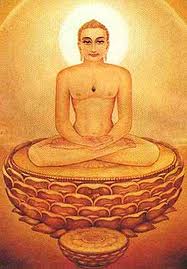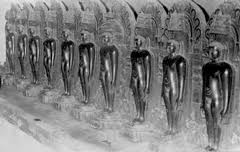Mahavira, like so many who change the world, was just a humble man. Born around 599 B.C.E at Kshatriyakund in what is now northeastern India, the man who would reintroduce the world to the teachings of the jina (one who has conquered their karma and is now liberated) arrived as a prince named Vardhamana. One story goes that Indra, king of the gods, bathed the young prince in heavenly milk soon after birth. Nice way to kick things off, if you ask me.
Even with all the comforts and extravagance of a princely life, Vardhamana lived a simple life and gave himself to renunciation at a young age. He spend much of his time in contemplation and meditation. According to legend, Vardhamana was a brave young man who often rescued his friends from hardships. In one account, he faced down an angel disguised as a terrifying monster. For Vardhamana’s courage, the angel named the boy “Mahavira,” which means “great hero.”

At age 30, Mahavira gave up his princely life and family, and spent the next 12 years as an ascetic. During these years, Mahavira withstood every pleasure and pain in the world with increasing equanimity. He regarding all forms of life with equal love and passion, including those who might harm him. He challenged all to live in peace and harmony, even in the face of great obstacles.
“The Venerable Ascetic Mahavira for a year and a month wore clothes; after that time he walked about naked, and accepted the alms in the hollow of his hand. For more than twelve years the Venerable Ascetic Mahivira neglected his body and abandoned the care of it; he with equanimity bore, underwent, and suffered all pleasant or unpleasant occurrences arising from divine powers, men, or animals.” –Kalpa Sutra 117
After 12 years spent in the crucible of unimaginable austerities and meditation, Mahavira reached omniscience as a jina (one who has shed all karmas) and used the remaining years of his earthly life teaching the path of the jinas as the 24th Tirthankara. He reached final liberation, moksha, at age 72.
Although Jain philosophy is thought to have existed in some form during Mahavira’s time, he is credited with reviving the teachings and propelling them into our current age. The Jain philosophy, taught by the previous 23 Tirthankaras (“ford-maker”), is thought of as having no beginning and no end. Each Tirthankara, one who has reached liberation, yet teaches the people the path to cross the sea of misery, taught the path during their age. Many scholars maintain that the previous 23 Tirthankaras were merely legend, while Mahavira was most probably a historical figure.

Time is eternal and cyclical according to Jain philosophy. In this way, each Tirthankara came and taught for their specific age and the ripples of those teachings flowed into and influenced the next. None of the teachings seem to contradict the other, but simply reaffirm or compliment. In each dispensation, Tirthankaras bring great social change to their populations and lead the way to liberation.
Although Mahavira was the last Tirthankara to appear on Earth, he is not considered the last. Each cycle receives a new Tirthankara. Jain philosophy also postulates that there is a living Tirthankara somewhere in the universe at any given point in time.
Images of the Tirthankaras adorn Jain temples all over the world (for those who believe in idols). These personalities, while venerated and worshiped, are not viewed as gods. Jain philosophy does not have a all-powerful, creator-god concept. Instead, it is the quality of the Tirthankaras and all liberated beings that is venerated. Devotees look to their example as “ford-makers” in order to cross the seemingly endless sea of death and rebirth, misery and pain. Indeed, the most important mantra in Jain philosophy, the Navokar Mantra, offers prayers to no specific personality, only to those nameless many who have crossed the sea of samsara (cycle of rebirth).
Namo Arihantanam
I bow in reverence to Arihants
Namo Siddhanam
I bow in reverence to Siddhas
Namo Ayariyanam
I bow in reverence to Acharyas
Namo Uvajjhayanam
I bow in reverence to Upadhyayas
Namo Loye Savva Sahunam
I bow in reverence to all Sadhus
Daily meditation includes reflection and emulation of the qualities and characteristics of these individuals.
Arihants are those who have shed their karmic bonds, yet still reside in the body. Siddhas are those who have reached final liberation and reached a bodiless state of pure bliss. Acharyas are the leaders within the Jain philosophy, Upadyayas are teachers, and the Sadhus are the monks and nuns along the path.
These are the examples and role models of every lay Jain, and why the laity supports the ascetic lives of these individuals.
What are some qualities held by these spiritual leaders that you could adopt in your own life? How do you feel about the path Mahavira took to teach the way of ahimsa (non-violence) and compassion toward all life?

